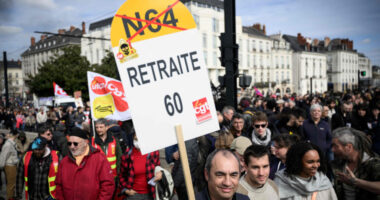
Many New Yorkers may not know where — or even what — Hudson Square is. But that is likely to change when thousands of employees of Google and Disney ABC, which are building new offices there, start pouring in over the next couple of years. The 33-square-block community between SoHo, the West Village and TriBeCa is prepared for some of those who want to live there, too: 18 new residential buildings have been completed since 2003, with two more in planning stages. And housing prices are still slightly lower than in the surrounding neighborhoods.
Jesse Luo, 27, a software engineer who moved to New York from San Francisco about a year ago, wasn’t familiar with Hudson Square when he started looking for an apartment. But he knew he wanted to be near Hudson River Park. “I do a lot of biking and walking,” he said, “and the West Side is best for going long distances.”
He found a three-bedroom, three-bath condominium with a terrace in a new building with a gym and common spaces where he could work, for about $3.5 million — “a good deal,” he said. The proximity of bars, restaurants and Chinatown were also pluses, along with the new Google and Disney offices, which he figured would make it easy to rent out his apartment in the next few years if he wants to.
“There is a lot of construction, a lot of development” in the area, said Phillip Salem, a real estate agent with Compass. “I think it will be an improvement.”
The “pivot point” came about five or six years ago, Mr. Salem said, when several luxury buildings hit the market and “brought attention to what was this no-man’s land in SoHo that became Hudson Square.”
But that development and the rising prices that come with it mean that some longtime residents “couldn’t move in now,” said Ronnie Peters, 58, a designer and photographer who includes himself in that category. In 2001, he was part of a group of people who pooled their money to buy two adjacent eight-story commercial buildings in what was then known as the printing district.
“You could literally smell the printers’ ink from the street and hear the presses, especially at night,” he said. The group converted the buildings to residential space, and Mr. Peters took over the entire fourth floor of one of the buildings two years later. Recently, a similar full-floor apartment sold for $3 million, which would be “restrictive” for him.
Cass Calder Smith, an architect and interior designer, was another early resident. In 2005, he bought two condos, at Greenwich and Spring Streets, and turned them into a single apartment. He also opened an office nearby, on Varick Street, in a 17-story building that has many architects as tenants. “I wanted to live in a place that I thought would have a good creative community, and I wanted to walk to work,” he said. “I kind of knew it was a burgeoning area.”
Mr. Calder Smith, 61, is now a board member of the local Business Improvement District, which has “made the neighborhood better,” he said, by adding parks, sidewalk benches and trees. Although the area is still sometimes referred to as West SoHo, it now feels more like a distinct place, he said: “People like to live in a neighborhood and know what it is.”
What You’ll Find
The area, as defined by the Business Improvement District, is bounded by Clarkson Street on the north, Canal Street on the south, West Street on the west and Sixth Avenue on the east, although the outline north of Vandam Street is a bit jagged and doesn’t always reach Sixth Avenue. Hudson River Park and Piers 34 and 40, while not technically part of the neighborhood, provide much of the recreational space, including bicycle paths, tennis courts and athletic fields.
While heavy traffic from the Holland Tunnel is an ongoing problem, the Business Improvement District has made an effort to prioritize “people over cars,” said Samara Karasyk, the organization’s president, and recently completed a 10-year plan that involved widening sidewalks, creating protected bike lanes, installing benches and planting hundreds of trees. The group has also renovated the Spring Street Park and created two new public spaces, Freeman Plaza East and Freeman Plaza West, in areas once used for collecting tolls near the Holland Tunnel.
A new 10-year plan, Ms. Karasyk said, includes “reimagining Houston Street between Varick and Washington,” which will become busier when the Disney ABC building at 137 Varick Street, also known as Four Hudson Square, opens in 2024.
Google, which recently paid $2.1 billion for St. John’s Terminal, a freight facility at 550 Washington, is incorporating it into a new 1.3-million-square-foot building that will cover two blocks and serve as the New York headquarters for the company’s global business organization when it opens next year. The builders have already knocked down structures that blocked views of Hudson River Park and added a passageway from Washington to West Streets, giving residents easier access to the park.
What You’ll Pay
Hudson Square may be a little more affordable than its better-known neighbors, but housing prices are generally high by Manhattan standards. Still, you can “get more bang for your buck” than in TriBeCa, the West Village or SoHo, said Mr. Salem, the Compass agent.
“I see it as being on the tipping point,” said Mickey Conlon, an agent with Douglas Elliman. “It’s only a matter of time before it hits parity” with surrounding areas.
In late August, more than 50 homes in Hudson Square were listed for sale on StreetEasy, which uses slightly different boundaries than those of the Business Improvement District. All but eight were condominiums. The least expensive was a studio co-op at 2 Charlton Street with a full-time doorman, a live-in resident manager and a courtyard on a tree-lined street, listed for $639,000; the most expensive was a four-bedroom, five-and-a-half-bath condominium at 565 Broome Street with Hudson River views, in a building designed by Renzo Piano with a 55-foot pool and a fitness center, listed for $20.95 million.
As for rentals, there were 20 homes available, from a one-bedroom, one-bath apartment at 30 Charlton Street listed for $3,750 a month, to a furnished five-bedroom townhouse with a private garden at 38 King Street for $35,000 a month.
The Vibe
Among the cultural offerings in Hudson Square are the Jackie Robinson Museum, which officially opened this month, honoring the baseball legend’s career and civil rights activism; the New York City Fire Museum, where New York Fire Department artifacts are displayed in a renovated Beaux-Arts firehouse; and the Children’s Museum of the Arts, temporarily closed.
Restaurants include casual spots like Pret a Manger and Le Pain Quotidien, and fancier places like Altro Paradiso, on Spring Street, and Café Hugo, in the new Hotel Hugo on Greenwich Street, which has two rooftop bars.
But the best-known restaurant and bar is the Ear Inn, which opened in 1817. The building, on Spring Street, was constructed around 1770 for James Brown, a Black aide to George Washington during the Revolutionary War.
The Schools
There are two public schools zoned for the neighborhood: P.S. 003 Charrette School, which had 600 students enrolled in prekindergarten through fifth grade during the 2020-21 school year, and Middle School 297, which had 818 students enrolled in sixth through eighth grade. Both are in Greenwich Village.
In 2018-19, the most recent school year for which ratings were available, 74 percent of students at P.S. 003 met New York State standards in English, compared with 48 percent citywide; 78 percent met standards in math, compared with 50 percent citywide. At M.S. 297, 66 percent of students met state standards in English, compared with 47 percent citywide; 60 percent met standards in math, compared with 41 percent citywide.
High School M560, City-As-School, is also in the neighborhood, although it is not a zoned school; students must apply to transfer from another high school. Established in 1972, it has an enrollment of 685 and, according to its website, is a place where “students learn by doing.” Jean-Michel Basquiat attended the school, but didn’t graduate.
The Commute
The 1 train stops at Canal and West Houston Streets at all times; the 2 train stops there late nights only. The C and E trains stop at Canal and Spring Streets; the A stops only at Canal. Buses include the M20 and M21.
West Street has eight lanes of traffic moving north and south, and the Holland Tunnel takes vehicles to and from New Jersey.
The History
On July 11, 1804, Vice President Aaron Burr left his estate, Richmond Hill, in what is now Hudson Square, to meet former Treasury Secretary Alexander Hamilton across the river in New Jersey for their infamous duel. Burr had bought the estate in 1794 from John Adams, who lived there when he was vice president, during George Washington’s first term as president. John Jacob Astor, America’s first multimillionaire, later bought the estate, moved the house to the southeast corner of what is now the intersection of Varick and Charlton Streets, and subdivided the land into lots for smaller homes. The grounds of the estate now constitute much of the Charlton-King-Vandam Historic District, known for its concentration of Federal and Greek Revival houses.
For weekly email updates on residential real estate news, sign up here. Follow us on Twitter: @nytrealestate.
Source: | This article originally belongs to Nytimes.com








